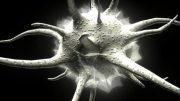
Researchers at Newcastle University have made significant progress in understanding life’s origins on Earth by simulating ancient hydrothermal vent conditions. This led to the creation of key organic molecules, potentially forming the earliest cell membranes. Their findings, crucial for comprehending life’s early development, also hint at the possibility of life’s genesis under icy moons’ surfaces in our solar system.
Newcastle University scientists, supported by the UK’s Natural Environmental Research Council, have been delving into the mystery of life’s emergence on Earth over 3.5 billion years ago.
They have explored the transformation of inert geological materials into the first living systems. Their experiments involved combining hydrogen, bicarbonate, and iron-rich magnetite under conditions similar to mild hydrothermal vents. This process resulted in a range of organic molecules, notably including fatty acids with up to 18 carbon atoms.
Published in the journal Communications Earth & Environment, their findings potentially reveal how some key molecules needed to produce life are made from inorganic chemicals, which is essential to understanding a key step in how life formed on the Earth billions of years ago. Their results may provide a plausible genesis of the organic molecules that form ancient cell membranes, that were perhaps selectively chosen by early biochemical processes on primordial Earth.
Fatty acids in the early stages of life
Fatty acids are long organic molecules that have regions that both attract and repel water that will automatically form cell-like compartments in water naturally and it is these types of molecules that could have made the first cell membranes. Yet, despite their importance, it was uncertain where these fatty acids came from in the early stages of life. One idea is that they might have formed in the hydrothermal vents where hot water, mixed with hydrogen-rich fluids coming from underwater vents mixed with seawater containing CO2.
The group replicated crucial aspects of the chemical environment found in early Earth’s oceans and the mixing of the hot alkaline water from around certain types of hydrothermal vents in their laboratory. They found that when hot hydrogen-rich fluids were mixed with carbon dioxide-rich water in the presence of iron-based minerals that were present on the early Earth it created the types of molecules needed to form primitive cell membranes.
Lead author, Dr. Graham Purvis, conducted the study at Newcastle University and is currently a Postdoctoral Research Associate at Durham University.
He said: “Central to life’s inception are cellular compartments, crucial for isolating internal chemistry from the external environment. These compartments were instrumental in fostering life-sustaining reactions by concentrating chemicals and facilitating energy production, potentially serving as the cornerstone of life’s earliest moments.
The results suggest that the convergence of hydrogen-rich fluids from alkaline hydrothermal vents with bicarbonate-rich waters on iron-based minerals could have precipitated the rudimentary membranes of early cells at the very beginning of life. This process might have engendered a diversity of membrane types, some potentially serving as life’s cradle when life first started. Moreover, this transformative process might have contributed to the genesis of specific acids found in the elemental composition of meteorites.”
Principal Investigator Dr. Jon Telling, Reader in Biogeochemistry, at the School of Natural Environmental Sciences, added:
“We think that this research may provide the first step in how life originated on our planet. Research in our laboratory now continues on determining the second key step; how these organic molecules which are initially ‘stuck’ to the mineral surfaces can lift off to form spherical membrane-bounded cell-like compartments; the first potential ‘protocells’ that went on to form the first cellular life.”
Intriguingly, the researchers also suggest that membrane-creating reactions similar reactions, could still be happening in the oceans under the surfaces of icy moons in our solar system today. This raises the possibility of alternative life origins in these distant worlds.
Reference: “Generation of long-chain fatty acids by hydrogen-driven bicarbonate reduction in ancient alkaline hydrothermal vents” by Graham Purvis, Lidija Šiller, Archie Crosskey, Jupiter Vincent, Corinne Wills, Jake Sheriff, Cijo Xavier and Jon Telling, 10 January 2024, Communications Earth & Environment.
DOI: 10.1038/s43247-023-01196-4
The study was funded by the Natural Environmental Research Council.









Interesting to say the least, the building proliferation of our human self. fire storm of biblical reasoning.